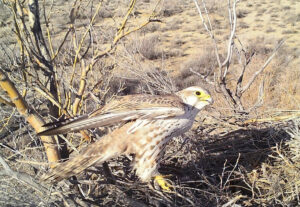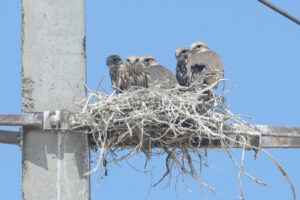Third International Scientific and Practical Conference “Eagles of the Palearctic: Study and Conservation”
Raptors Conservation. Suppl. 2. Proceedings of Conferences
About the Saker Falcon Situation in the Southern Balkhash Region in the South-East of Kazakhstan
Zhatkanbaev A.Zh. (Institute of Zoology, Almaty; NGO “Ecological Club”; Ile-Balkhash State Nature Reserve of the Forestry and Wildlife Committee under the Ministry of Ecology and Natural Resources of the Republic of Kazakhstan)
Shmygalev S.S. (Sunkar Falcon Center, Almaty, Kazakhstan)
Dosov N.M. (NGO “Ecological Club”, Kazakhstan)
Grachev A.A. (Institute of Zoology, Almaty; Community Trust “Wildlife without borders”, Kazakhstan)
Musyrpanov E.S. (Ile-Balkhash State Nature Reserve of the Forestry and Wildlife Committee under the Ministry of Ecology and Natural Resources of the Republic of Kazakhstan)
Contact:
Altai Zhatkanbaev kz.wildlife@gmail.com
Sergey Shmygalev shmyga-sunkar@mail.ru
Nurlan Dosov nurland007@mail.com
Aleksey Grachev Aleksey.Al.grachev@gmail.com
Ermek Musyrpanov Ile-balkhash@mail.kz
Recommended citation: Zhatkanbaev A.Zh., Shmygalev S.S., Dosov N.M., Grachev A.A., Musyrpanov E.S. About the Saker Falcon Situation in the Southern Balkhash Region in the South-East of Kazakhstan. – Raptors Conservation. 2023. S2: 459–462. DOI: 10.19074/1814-8654-2023-2-459-460 URL: http://rrrcn.ru/en/archives/35229
Saker Falcon (Falco cherrug) has been a breeding and wintering species in the southern shore of Lake Balkhash region for the last two decades. There is a publication describing the first known case of the Saker Falcon nesting there in 2013 and the wintering of a pair in the transition landscape of wetland to desert biome landscape of this geographical area (Zhatkanbaev, 2014).
By the end of 2017, the nesting population of the species numbered at least 20 pairs. Saker Falcons nested both in the Ile River and Karatal River floodplain areas, and their nests were located directly in the desert areas of the Ile-Karatal interfluve. Here pairs occupied nests of both Long-Legged Buzzards (Buteo rufinus) and unoccupied old nests of Golden Eagles (Aquila chrysaetos) and Brown-Necked Ravens (Corvus ruficollis), often located on the power transmission poles of 35kV power lines.
In February 2015, a pair of Saker Falcons was able to drive a pair of Long-legged buzzards out of their nest, which had been continuously occupied for the previous 4 years, and the buzzards were forced to occupy and renovate an old dilapidated nest 200m away from the main nest. The pair of Saker Falcons then successfully hatched chicks in the Long-Legged buzzards’ nest.
The main prey item of Saker Falcons in the southern shore of Lake Balkhash in the period of 2013-2023 was the Great Gerbil (Rhombomys opimus). Interestingly, in May 2015, adult Saker Falcons had fed their nestlings with Rooks (Corvus frugilegus), including whole carcasses. They had been hunted in the nesting colony in Karaoy village 22–25 km away, causing considerable disturbance in the Rook colony.
Additionally, among the prey species of the Saker Falcon were the Steppe Agama (Trapelus sanguinolentus) and fish, namely carp (Cyprinus carpio). It also fed on carrion. After setting Reconyx and Bushnell camera traps, it was observed that on March 22, 2017, a male Saker Falcon flew into a rather dense thicket of trees, mainly consisting of Poplar (Populus deversifolia), and, descending to the ground, managed to grab an adult Muskrat (Ondatra zibethicus) and fly away with it.
During nesting of Saker Falcons in the southern shore of Lake Balkhash, the fact of cainism among Saker Falcon chicks was established, when on May 15, 2017 one of them was observed on the ground, eating another chick that died, apparently as a result of electric shock (the nest of falcons was located in an abandoned nest of a Brown-necked raven built on a power transmission pole), whereas 5 healthy, fully feathered chicks had been observed in the nest the day before.
In 2021, the abundance of Great gerbil, the main local prey species of the Saker Falcon, was depressed, and as a possible effect of this, the relative abundance and occurrence of the Saker Falcon was extremely low in spring and summer of that year. Another possible reason for the decrease in the number of nesting pairs of Saker Falcons in this region could be the ongoing pressure of spontaneous illegal falcon capture in Kazakhstan, as news of such facts are still published both in the media and on social networks. In late summer and fall of 2022, adult Saker Falcons started to reappear in their former breeding areas, and were observed near Brown-necked raven nests on power transmission poles. Possibly, the same breeding pairs of Saker Falcons gravitated to such old and newly built Brown-necked raven nests after their removal by power engineers. In late July, late August, and early September 2023, individual falcons as well as pairs were observed near power transmission poles with Brown-necked raven nests.


